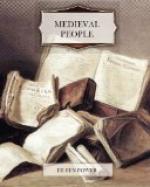the wealthiest traders in the country. For these
and other reasons the Government adopted the custom
of fixing staple towns, which acted as centres of
distribution through which the export trade was forced
to go. The location of the Staple was altered
from time to time; sometimes it was at Bruges, sometimes
at Antwerp, sometimes in England; but usually it was
at Calais, where it was first fixed in 1363 and finally
established in 1423. Through the Staple all wool
and wool fells, hides, leather, and tin had to pass,
and the organization of the system was complete when
the body of wool merchants, in whose hands lay the
bulk of the Staple trade, were finally incorporated
in 1354, under the governance of a mayor. The
system was a convenient one for Crown and merchants
alike. The Crown could concentrate its customs
officers in one place and collect its customs the
more easily, particularly as a method was gradually
developed by which the custom and subsidy on wool
was paid to the Royal officials by the Fellowship
of the Staple, who then collected it from the individual
members. The merchants, on the other hand, benefited
by the concentration in trade: they were able
to travel in groups and to organize convoys to protect
the wool fleets from pirates who swarmed in the narrow
seas between England and France; as members of a powerful
corporation they could secure both privileges and protection
in Flanders. Moreover, the wool buyers also benefited
by the arrangement, which rendered possible a careful
surveillance by the Crown and the Company of the Staple
of the quality of the wool offered for sale, and a
series of regulations against fraud. It must be
remembered that in days when trade stood in need of
a protection which the Government was not yet able
to give it, there was nothing unpopular in the idea
of giving the monopoly of the staple trade to the
members of a single company. ‘Trade in
companies is natural to Englishmen,’ wrote Bacon;
and for four centuries it was the great trading companies
which nurtured English trade and made this country
the commercial leader of the world.
The wool trade throve in England until the close of
the Middle Ages, but throughout the fifteenth century
the staplers were beginning to feel the competition
of another company—that of the famous Merchant
Adventurers, who, taking advantage of the growth in
the native cloth manufacture during the previous century,
had begun to do a great trade in the export of cloth.
This was obnoxious to the staplers, who desired the
continuance of the old system, by which they exported
English wool to the Continent, where at Ypres and
Ghent, Bruges and Mechlin, and the other famous cloth-working
cities of the Netherlands, it was woven into fine
cloth. This cloth manufacture gave to the Netherlands
a sort of industrial pre-eminence in Europe throughout
the Middle Ages, and it was dependent entirely upon
a good supply of English wool, for the next best wool
in Europe—that of Spain—was not
satisfactory unless mixed with wool of English growth.
Hence the close political tie between England and
Flanders, the one needing a customer, the other an
essential raw material; for, as a fifteenth century
poet said,




